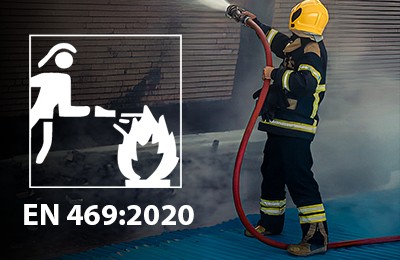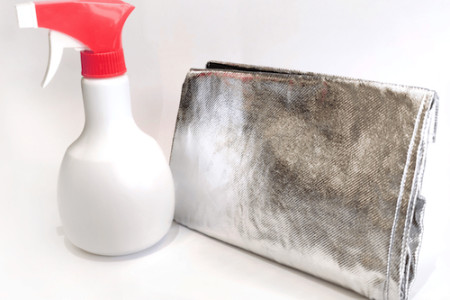EMERGENCY SAFETY SHOWERS & EYE/FACE WASHES
Emergency safety showers and eye/face washes are special occupational safety equipments designed to wash chemicals or toxic substances that come in contact with skin, eyes or clothing, meeting the requirements of international standards. Emergency showers can be defined as a first aid equipment that should be used as a necessity for emergency response to reduce the effects of accidents at a workplace. Since these are the products which are directly related to human health, it is a necessity to produce them in accordance with the relevant European and / or American standards and carry the markings of the relevant standards.
The Occupational Safety and Health Administration (OSHA) has defined it clearly what types of workplaces are required to have an emergency shower (“Where any person's eyes or body may be exposed to harmful corrosive substances, suitable facilities shall be provided for immediate use in the workplace for immediate washing of eyes and body”). The second OSHA regulation in this area specifies certain industries that should include emergency shower and eye/face wash equipment in each facility. These industries include manufacturing of open surface tanks, storage and handling of anhydrous ammonia, cellulose, paper and cardboard and other hazardous materials.
Explosion proof (ATEX as per the European norms) emergency safety showers must be used for safe use in potentially explosive atmospheres. Such situations can be found in offshore oil and gas, marine vessels, refining and petrochemical industries, food processing, pharmaceuticals, breweries and distilleries as well as firefighting, water treatment and gas distribution. The ATEX Equipment Directive 2014/34/EU covers electrical and mechanical equipment for use in potentially explosive atmospheres. Only ATEX compliant equipment must be sold for use within the EU in explosive atmospheres.
The requirements and competencies of emergency shower and eye/face washes are specified in EN 15154 in Europe and ANSI/ISEA Z358.1-2014 in North America (generally accepted in the Middle East and non-European countries). European standards for emergency safety showers, eye/face washes and decontamination units are as follows.
EN 15154-1 : Plumbed-in body showers for laboratories
EN 15154-2 : Plumbed-in eye wash units
EN 15154-3 : Non-plumbed safety shower for the body
EN 15154-4 : Non-plumbed safety shower for the eye
EN 15154-5 : Emergency safety showers. Water overhead body showers for sites other than laboratories (Class I, II, II)
EN 15154-6 : Emergency safety showers. Plumbed-in multiple nozzle body showers for sites other than laboratories (Decontamination Units)
The equipment defined as the only eye wash in the EN standard is divided into two as eye/face wash and only eyewash in ANSI/ISEA Z358.1-2014 standard. It can be said that an emergency shower meets the requirements of OSHA if it has ANSI standard.
According to the ANSI standard, certain amounts of water flow for emergency showers, which must flow continuously for 15 minutes, are clearly determined (75.7 l / min for body shower, 1.5 l/min for eye wash, 11.4 l/min for eye/face wash). These flow rates must also be met if both the body shower and the eye or eye/face wash operate simultaneously.
Since there is no water network in each workplace, only emergency showers connected to the mains water supply are not sufficient and enough and cannot meet the requirements of the users. For this reason, it is necessary to provide emergency showers with water tank with capacity that can provide 15 minutes of water flow which is required by ANSI standard.
More importantly, according to ANSI standards, the temperature of clean, potable water supplied from the emergency shower must be maintained at 16-38°C in any climatic condition regardless of whether it is installed outside or inside of the building. In addition to that, the emergency shower must always be ready to use in case of an emergency. The necessity of heating the water in cold climates such as in Russia and cooling the water in hot climates such as in Middle East is revealed in the emergency showers to be installed in the plants.
Emergency showers are divided into two groups as plumbed-in type and non-plumbed with water tank. Non-plumbed tank showers are preferred in the following cases:
• In case there is no mains supply in the facilities where the systems will be installed,
• In case the emergency showers are installed at outdoor or in open spaces without mains supply,
• In case of inadequate water pressure for emergency showers in the existing mains supply,
• In case of interruptions at the existing mains supply,
• When there is a need to cool or heat water with low energy at high or low ambient temperatures to keep water ready to use at a temperature of 16-38°C, which is required by standards.
Plumbed-in and non-plumbed emergency showers are also divided as indoor or outdoor use. Units suitable for outdoor use should be the system which are scald-proof for hot climates and freeze-proof for cold climates.
The water remaining in the pipes of the emergency shower can quickly heat up in hot climates, scald the user while using, and in cold climates, freezing water can clog the pipe and cause the shower not to operate. In cases where such risks are present, self-draining systems or units equipped with specially designed anti-freeze or anti-scald valves should be preferred. In the pipes of emergency showers, water will not be heated or freezed in the pipe after use with these special valves. The systems are completely mechanical and do not require any electrical consumption.
Freeze protection can also be provided in emergency showers designed as insulated and trace heated. The purpose of trace heating is not to provide tepid water, but to ensure that the water remaining in the pipe does not freeze at up to -40°C ambient temperature. A wiring connection is needed for these systems. Freezing is prevented by heating the pipes by electical cables. With the help of a safety thermostat, the water in the pipe is prevented from overheating and causing harm to the user.
The materials of the emergency shower (emergency shower, eye wash, water tank, cabin, etc.) should be determined according to the conditions in the area where the units will be used according to the types of chemicals in the workplace. For instance, in the food industry that is kept hygienically clean, it is recommended to use 304 grade stainless steel, 316 grade stainless steel material is recommended in workplaces where hazardous and corrosive substances are likely to be exposed, such as offshore, pharmaceutical or chemical industries.
Decontamination Units
Contamination is defined as the pollution and contagion of materials, objects, people, area or structure by undesirable microorganisms, harmful industrial chemicals and/or warfare agents in combat situations, chemical-biological attacks and industrial chemical exposures.
Decontamination is the process of chemical cleansing, sterilization, cleaning and removing with antisepsis in the first intervention, in case of possible vital risks involved in these kind of events which are in the scope of civil defense and occupational safety.
Within the scope of the Disaster Response Plan, duties and responsibilities of related institutions and organizations and the equipments to be used are defined. In such cases, the distance to the hazardous area, the number of people exposed, transportation and intervention opportunities are the basic information for choosing a suitable decontamination system.
Chemical, biological, radiological and nuclear defence are protective measures taken in situations in which chemical, biological, radiological or nuclear warfare (including terrorism) hazards may be present. Apart from industrial contamination, in case of CBRN attacks during a warfare, the zones are classified as hot, warm and cold according to the distance to the place of the hazard.
Hot zone (Exclusion zone): This is the area where contamination is most intense. The authorized institutions in this zone are responsible for activities such as intervention, evacuation and decontamination to be carried out here. In this zone, gas-tight protective suits are used. It is important that the equipment to be used here, such as the decontamination unit, should be portable and easy to install for quick intervention. The decontamination capacity of the equipment installed in this zone is therefore limited.
Warm zone (Contamination reduction zone): It is the area where the first medical attention will be given to those who are exposed to the hazard. It is the mutual responsibility area of the authorized institutions, where logistics and decontamination are carried out. In these regions, fixed or portable type, easy to install and high capacity decontamination systems can be used. Decontamination systems can be equipped with inflatable or non-inflatable tents, clean and waste water tanks, energy supply systems.
Cold zone (Support zone): These are the medical intervention areas where the patients whose triage and decontamination have been completed in the warm zone are referred. CBRNe reference hospitals determined by the Ministry of Health at the regional and city scale are authorized to be used in these cases. Hospitals have generally higher capacity of fixed type decontamination systems. The protective clothing used in these areas is sterile and/or liquid-particle-protective form of disposable coveralls.
Doruk TÜRKUÇAR
IST Safety Ltd
Export Manager
HSE Professional








Your Comments